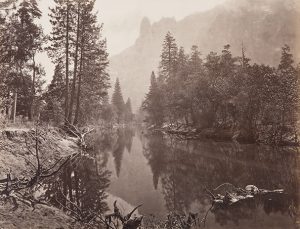
![]() Before the first non-native people entered Yosemite Valley in 1849, it was home to a Native American tribe known as the Ahwahneechee, who lived in the region for over 3000 years. In the mid-nineteenth century, the United States army drove them out of what we now call Yosemite National Park. One of the first white settlers to make his home in the valley was Galen Clark. Clark established a hotel for visitors in the Mariposa Grove, home to the Giant Sequoia trees.
Before the first non-native people entered Yosemite Valley in 1849, it was home to a Native American tribe known as the Ahwahneechee, who lived in the region for over 3000 years. In the mid-nineteenth century, the United States army drove them out of what we now call Yosemite National Park. One of the first white settlers to make his home in the valley was Galen Clark. Clark established a hotel for visitors in the Mariposa Grove, home to the Giant Sequoia trees.
In 1861 the most important early photographer to visit the Yosemite region, Carleton Watkins, had a mammoth camera constructed to hold 18 x 22 inch glass plate negatives. Entering the valley with a twelve-mule pack train, he not only brought his camera and glass plates but also chemicals, a portable darkroom, and other equipment, including a camera designed to take small paired photographs called stereographs. These would be viewed through a special stereoscope that would merge the two images into one with the illusion of three-dimensional depth. Together with his mammoth plate photographs, Watkins’ stereographs helped raise public awareness about the wonders of Yosemite Valley.
Watkins returned multiple times to the valley in 1861, and again in 1865 and 1866 while working for the California State Geological Survey. Although his stereographs only provided Anglicized names for landscape features, his mammoth plate photographs frequently gave both the Ahwahneechee and the English versions of places with titles such as Piwyac, the Vernal Fall and Pompompasos, the Three Brothers.
Partly on the evidence of Watkins’ extraordinary photographs, in 1864 Abraham Lincoln signed a bill declaring the valley protected, paving the way for the national Parks system. Other photographers soon made their way to Yosemite. Eadweard Muybridge, better known for his studies of human and animal locomotion, photographed the region in 1867 and again in 1872. Using the long exposures required by the technology of the day, early photographers pictured rivers as smooth surfaces and waterfalls and blurred flowing water.
In 1890, an act of Congress created Yosemite National Park. With the completion of the Yosemite Valley Railroad in 1907, tourists began visiting the area in droves. Among them was the fourteen-year-old Ansel Adams, who roamed the valley taking snapshots with a Kodak box camera. In 1927, Adams would produce his first important series of Yosemite photographs, Parmelian Prints of the High Sierras. Adams would continue to photograph Yosemite for the rest of his career, producing the iconic wilderness photographs that established his reputation as the best-known American landscape photographer of the twentieth century.